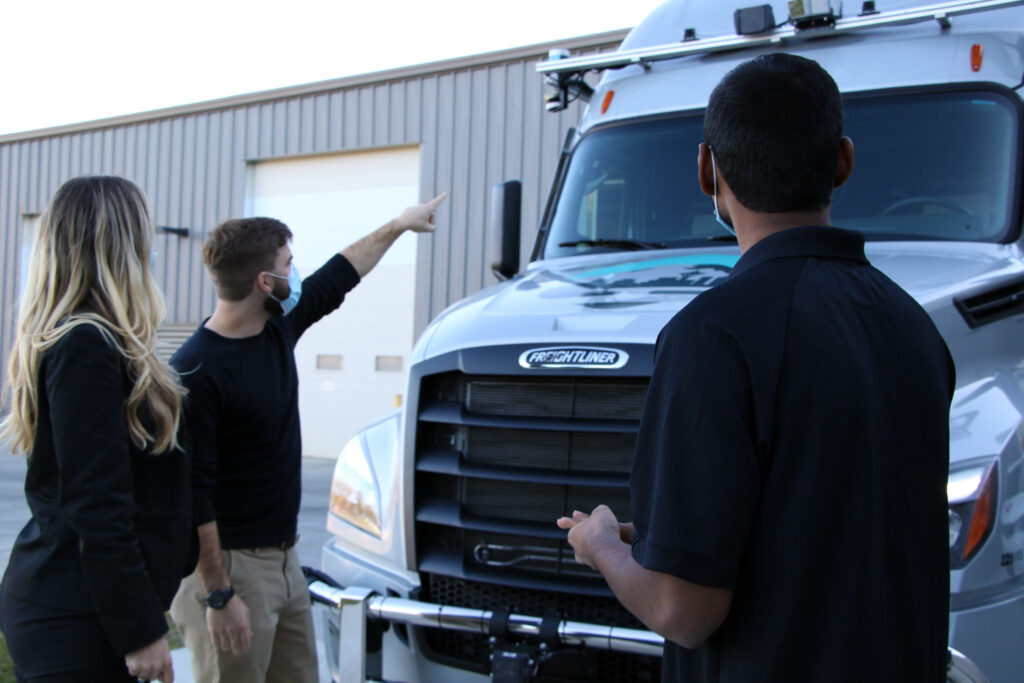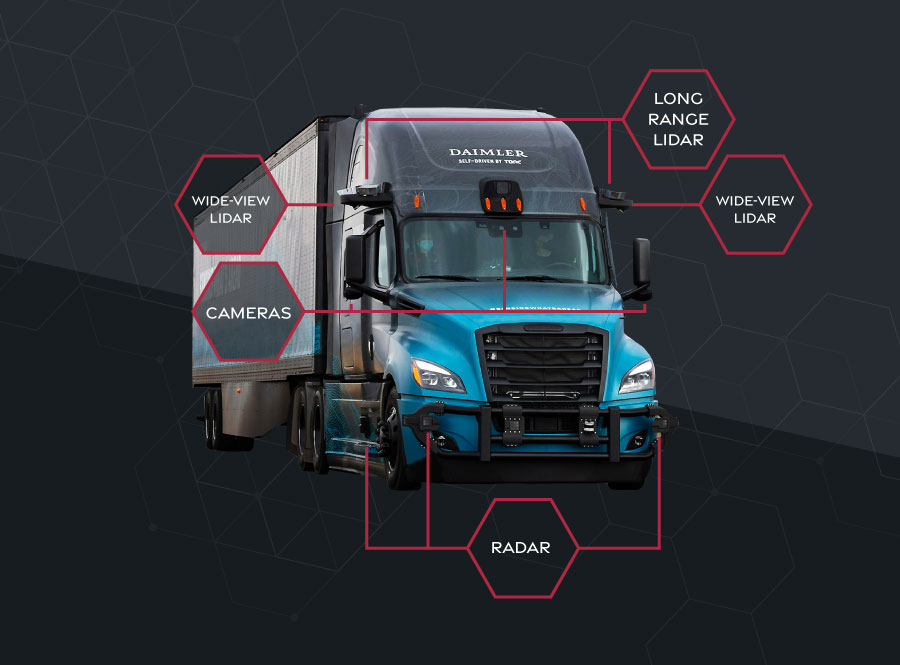Picture this: A freight truck travels down the highway. Because of the truck’s size, its driver has better visibility than other vehicles on the road, but they cannot see everything. A compact car moves into the passing lane and enters the truck’s blind spot. Ahead of the truck, a minivan slams on its brakes to avoid hitting the vehicle in front of it. The driver of the freight truck must perceive these dangers, decide how to react, and immediately maneuver to prevent multiple accidents and keep the truck upright.
This scenario would confound human drivers with millions of miles of driving experience. Driving conditions can change in the blink of an eye, but, on the road, there is no room for mistakes. A delayed reaction can be the difference between life and death.
How does Torc’s self-driving truck system see, think and act in these situations?
Perception at Torc

The Perception team at Torc is critical to our mission of safe driving. The team is composed of expert engineers, each with their own specialty, who have decades of experience developing self-driving technologies and a passion for robotics. The hardware suite for our trucks includes different sensors, such as RADAR, short and long-range LiDAR and cameras. The Perception team creates algorithms that translate raw sensor information to ensure that our vehicles can accurately visualize, localize and react appropriately to their environment.
Our self-driving system converts raw sensor data into representations of the real world in real-time as it traverses the highway. The Perception team creates the pathways to turn that data into actionable information.
As part of Perception, Mapping and Localization teams create Torc’s highly detailed HD maps that, along with GPS and other systems, allow our vehicles to navigate their routes.
Active Sensing and Information Fusion teams create algorithms that combine sensor data to detect and identify objects for Torc’s autonomous driving system. We also utilize machine learning to analyze this data to classify objects in further detail. For example, machine learning can identify different colored traffic lights or determine the difference between a pedestrian and a light post.
With their expertise and tools, Perception gives unparalleled vision to Torc’s self-driving system. Other software engineering teams at Torc then use this information to develop behaviors for the system.
The Culmination of Our Work
Since its inception over 15 years ago, Torc has successfully developed and deployed self-driving technology across a wide array of industries. The Perception team has abundant experience giving sight to our self-driving solutions for large, heavy-duty vehicles in the defense and mining industries that must be dependable, accurate and able to operate under a variety of conditions. This makes Torc uniquely positioned to tackle the many challenges of automating trucks. Trucks and truck driving are, by their very nature, radically different from that of passenger vehicles, and our Perception team is working to solve the specific challenges that come with developing perception for trucks.
Focusing on the Big Problems
Long-haul trucking accounts for 69% percent of all freight activity in the U.S. Torc has chosen to focus on this environment for self-driving trucks because of the reduced complexity. Highways provide a well-maintained environment with a more predictable set of scenarios than urban or rural roads. Specifically, coding for self-driving on highway settings allows our engineers to focus on specific problems. Highway signs and lane markings are also regular and consistent, making them easier for cameras and sensors to spot and interpret. Many rural roads, on the other hand, do not have such lines or signs. The types of objects that must be identified and the corresponding maneuvers a truck must perform on a highway setting are significantly reduced. Highway driving does include challenging scenarios such as merging and passing on multi-lane highways. This is why we still perform rigorous testing in simulation and closed courses – and why high-fidelity perception is so important at highway speeds.
Knowing Where We Stand
Our self-driving trucks make their journey using a combination of Torc’s proprietary HD maps, GPS and state estimation software to navigate their routes. GPS installed in the truck hardware helps with navigation, but while GPS can provide general guidance on highways, reliability and precision can vary. Used by itself, GPS could lead you into a lake instead of your intended on-ramp. Also, there are still large swaths of the country that lie in GPS degraded or denied areas. Autonomous driving requires a solution that provides precision. Our Mapping and Localization team can map and maintain routes for accuracy with our own vehicles using sensors, software and other localization data.
Solutions of Epic Proportions
Freight trucks are larger than and not as maneuverable as consumer vehicles. These differences translate into slower acceleration and increased braking distance than their four-wheeled counterparts. Freight trucks weigh around 35,000 pounds on average and require more than twice the length of a passenger vehicle to come to a complete stop. This stopping distance can double when a truck is carrying a maximum load of 80,000 pounds. As a result, truck handling is limited and maneuvering requires more surface area than passenger vehicles. Truck driving behavior must be designed to accommodate these facts. Our engineers take these differences into account when tuning the system to help the truck decide how much distance is needed to follow other vehicles safely or how much space is needed to prevent the truck from jack-knifing in a turn.

Seeing Everything
Because of their size and the additional length of their trailers, trucks are naturally self-occluding. Large portions on all four sides of the truck are blind spots for the driver. Passenger vehicles driving in these spots are difficult, if not impossible, to see. Our engineers meet some of the unique challenges that trucks present by adding a robust sensor suite that improves visibility around the truck. Long-range LiDARs, for example, provide object detection farther down the road to accommodate the trucks’ need for increased stopping distance. Sensors that provide coverage at the truck’s blind spots can assist with complex scenarios such as merging into multiple lanes of fast-moving traffic. As we continue to tackle the unique challenges of automating large semi-trucks, each improvement brings us one step closer to our goal: a robust autonomous driving system that increases road safety and freight efficiency.
What It Takes to Be Part of Perception
Now that you know some of the challenges our Perception team is tackling with trucking, you may be wondering, “What makes an ideal Perception team member?” Our team members are a curious collective of problem-solvers who aren’t afraid to ask questions. The belief that self-driving technology can help save lives fuels their pursuit of innovation. They approach problems related to perception with a beginner’s mindset and craft solutions using their extensive expertise. They’re also open to continual improvement and find fulfillment working as a team to overcome the hard problems facing perception and artificial intelligence. Learn more about Torc software engineers.
Join us!
If you enjoyed reading about how our Perception team is overcoming challenges related to trucking and would like a rewarding career with opportunities to learn, innovate, and contribute to a world-changing mission, we would love to hear from you. Interested in helping engineer the future of autonomous trucking?
